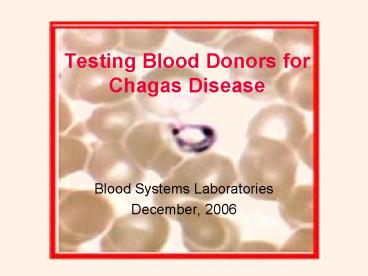Testing Blood Donors for Chagas Disease - PowerPoint PPT Presentation
1 / 18
Title:
Testing Blood Donors for Chagas Disease
Description:
Reduviid bugs live in mud filled walls of huts in rural areas ... No transmissions in lookback studies on 35 tested recipients in US studies (ARC and REDS-I) ... – PowerPoint PPT presentation
Number of Views:53
Avg rating:3.0/5.0
Title: Testing Blood Donors for Chagas Disease
1
Testing Blood Donors for Chagas Disease
- Blood Systems Laboratories
- December, 2006
2
Trypanosoma cruzi and Chagas Disease
- The etiological agent of Chagas disease is the
intracellular protozoan parasite Trypanosoma
cruzi (T. cruzi), which is transmitted by the
insect vector Triatoma infestans (reduviid bug) - Reduviid bugs live in mud filled walls of huts in
rural areas - The bug bites human hosts and transmits the
parasite
Triatoma infestans (Reduviid bug)
Trypanosoma cruzi with human erythrocytes
3
Chagas Disease
- Acute stage Immediate reaction to infection
- Only occurs in about 1 of people infected
- Swelling of the eye, tiredness, fever, rash, loss
of appetite - Can be fatal for infants, young children and
immunocompromised recipients - Intermediate 8 to 10 weeks after infection
- No symptoms
- Chronic 10 to 20 years after infection
- Enlarged heart and digestive tract
- Can result in heart failure
- Little effective therapy (toxic drugs/low cure
rates)
4
Where is Chagas Disease Found?
- Primarily found in Latin America (16-18 million
infected) - Increased infections are being detected in the
United States
5
Increasing Prevalence of Donors at Risk for
Chagas Disease in the U.S.
6
The case for screening
- T. Cruzi establishes a chronic, asymptomatic,
untreatable infection leading to serious disease - Endemic in Mexico, C. America and S. America
- Immigration and blood donation patterns indicate
potentially infected donors throughout the US - T. cruzi ab demonstrated in US blood donors in
multiple geographic locations (ARC estimated rate
of 125,000 nationally) - 63 of positive donors were parasitemic (however,
parasitemia is not necessarily infectivity) - 7 tx-transmitted cases in North Americathese are
acute fulminant cases, but other cases are being
missed - Serious morbidity/mortality for recipients
7
Transfusion-transmitted T. cruzi cases in the US
and Canada
All patients were immunocompromised disease was
acute and fulminant in 6 cases platelets were
transfused component in all 6 cases with data
- 1987 California via Mexican donor
- 1989 New York City via Bolivian donor
- 1989 Manitoba via Paraguayan donor
- 1993 Houston via unknown donor
- 1999 Miami via Chilean donor
- 2000 Manitoba via German/Paraguayan donor
- 2002 Rhode Island via Bolivian donor
- identified prospectively
Reference Source Dr. D. Leiby, American Red Cross
8
Other transfusion-transmission data
- Estimated tx-transmission rate from T. cruzi
positive units in endemic areas is 13-26 - No transmissions in lookback studies on 35 tested
recipients in US studies (ARC and REDS-I) - Only 3 were platelet recipients and platelets
appear to be the component most at risk (11
received rbc, 5 plasma, 16 unknown) - In vitro parasite survival studies on units
spiked with T. cruzi - Platelets - 4 days
- Red cells may be up to 3 weeks
- Whole blood - 3 weeks
- Plasma no recovery
9
US Transplant CasesMMWR reports
- Three cases from a single donor reported in 2001
- Donor from Central America, presumed infected
with T. cruzi but never tested - Infected patients received kidney and pancreas,
liver, and kidney one recipient died of acute
Chagas myocarditis 2 weeks post treatment - Two heart tx recipients from separate donors in
2006 - In both cases organ donor was RIPA pos (but IFA
neg/eqiv) and co-recipients of kidneys and liver
were uninfected - Both recipients resolved parasitemia with
treatment
10
Seroprevalence Studies
Leiby et al., Transfusion 2002
Los Angeles Miami Total no.
donations 1,104,030 181,139 Yes to risk
question 78,736 (7.1) 25,908
(14.3) Number tested 77,967 25,352 EIA
repeat reactive 329
75 Confirmed by RIPA 147 (0.2)
20 (0.1) Seropositivity rate 1 in
7,500 1 in 9,000
including one young female donor who responded
no to the question
11
LA Seroprevalence 1996-98
Overall rate in Allogeneic donors1/7,200 Pheresis
1/93,000 Directed1/2,400
1/5,400
0.018
0.016
1/7,200
0.014
0.012
1/9,900
0.010
Donors Positive
0.008
0.006
0.004
0.002
0.000
1996 1997 1998
12
Recent U.S. Chagas Testing
- Ortho expanded 2006 clinical studies to include
areas where T. cruzi antibody prevalence
previously documented - Pivotal Clinical Trial yielded 0 confirmed pos of
40,665 - Previous preclinical study 3 in 10,000 in El
Paso - Additional testing for donors from So Cal, No Cal
and AZ (West ARC Division) - Over 100,000 donations tested with reactive rate
12,500 - Unlinked prevalence test results pending
13
Comparison of Prevalence Studies
12000
15400
17200
19000
14
The FDAs position?
- It is our current thinking that when a good test
comes along that fits the criteria, it will be
recommended
Dr Nakashi 2002 BPAC
15
Status of Testing for T. cruzi in the U.S.
- Ortho receives license for T. cruzi antibody test
on 12/13/06 - Abbott antibody test using recombinant antigens
on Prism is in development - ARC and BSI implementing universal screening in
early 2007
16
Chagas Issues
- Universal vs. Selective Testing
- By geographic regions
- By lifetime testing (one time per donor)
- Ethnicity or country of origin
- Strategies for Confirmatory Testing and Donor
Counseling - Look-back policy development
- Implications for public health labs
17
Blood Systems Strategy for T. cruzi Antibody
Testing
- Implement licensed test in both laboratories by
February 1, 2007 - Develop a research study and gather data to
determine the optimal testing strategy for T.
cruzi - Begin testing all UBS/BCP donors by February 26,
2007
18
Blood Systems Strategy for T. cruzi Testing
(cont.)
- Collect and analyze data
- Make recommendations to FDA for future approach
based on data analysis - Communicate with hospitals and testing customers































